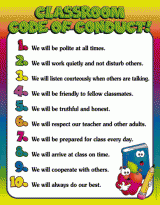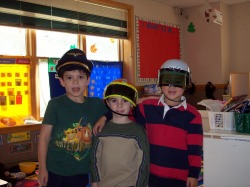"Words of encouragement, a little respect, simple gestures of kindness from a teacher promote the perfect climate for students to study, learn, and grow."
~Donna Fargo
Classroom Management
Classroom Code of Conduct

'Developing a classroom Code of Conduct should be done the first day of school. I prefer to use "code of conduct" as opposed to "rules" because it eliminates the belief that teachers use rules to control students. Instead, a code of conduct describes how everyone should behave and work with each other. It promotes responsibility by holding everyone accountable for their actions including the teacher. The code of conduct is taught to the students by listing appropriate and inappropriate behaviors and reflecting on what kind of classroom they would like to be a part of. Role-playing, modeling, explanation and parent input are part of teaching the code of conduct. I feel that the parent input is a crucial part of the process because it gets the parents on board with the teacher from day one and shows that the teacher values parent input. The code of conduct also sets up a system for dealing with misbehavior.
By designating classroom jobs for each of the students, it gives them the opportunity to practice independence as well as fostering responsibility. Instead of me being in charge of keeping the classroom neat and organized, it is a group effort that includes both me and the students. The grade level determines the type of jobs that the students will be assigned. In the past, I have given the students a job for the week. On Monday morning, they receive new jobs. Each student has a job everyday so that everyone is always included. I keep a description of the job posted next to the job chart so the students can review their responsibilities as needed.
Magic Number
On the first day of school, each student is assigned a "magic number." The number is used to label mailboxes, cubbies, classroom supplies, etc. I also use the numbers in a classroom behavior system that is discussed below.
Whole Class Behavior System
As a novice teacher, I have spent a lot of time observing and researching different classroom behavior plans that I think would work for me. I have combined several ideas from other teachers I have observed, books I have read, and my own ideas and created a simple system that works for me.
Tokens: I have small counting chips that I label with each student's magic number. Each of the students have several chips. These chips are their tokens. Students can earn tokens for exhibiting appropriate classroom behaviors, showing a specific character counts trait, getting a compliment from another teacher, etc. At the end of each week, students can trade in their tokens for a reward. Each reward costs a certain number of tokens. For example, a prize out of the prize box (filled with pencils, small erasers, stickers) is only 1 token, but lunch with the teacher and a friend of their choice is 20 tokens. Students can save their tokens to work towards a reward that might not be reachable within one week such as lunch with the teacher or they can trade in all of their tokens each week. I think this system gives the students the independence and responsibility of making their own choice about their rewards.
I also have class tokens. Class tokens are awarded when the whole class the exhibits the appropriate behaviors, character counts traits, etc. At the beginning of the year, class rewards are decided on and a list is created with the reward choices and their individual cost. The class tokens are traded in at the end of each month. The students vote to decide the class reward.
Classroom Meetings: I want my students to feel that they are an active part of our classroom community. Classroom meetings are a healthy avenue to ensure that every has a voice. During classroom meetings everyone has the opportunity to contribute their opinion and suggestions about what is happening in the classroom. During this time, we will discuss the problems that are occurring in the classroom. At the beginning of the year, we will practice the elements of a class meeting such as forming a circle, giving and receiving compliments, the agenda, communication skills, etc. This is also a time where the classroom reward will be decided on. Since I come from a counseling background, I see classroom meetings as having the same effect as group counseling. They both provide a forum for students to share their concerns with school/classroom, they give the opportunity for feedback and suggestions for improvement, and they establish a bond between members. I believe that classroom meetings will eliminate many behavior problems in the long-term because they involve everyone in the process, they teach students how to communicate with each other, and the students learn how to problem-solve.
Clip Chart: Sometimes students need a more structured concrete behavior system than just the tokens. The clip chart is very similar to the red, yellow. green light system that many teachers use except it provides an opportunity for positive reinforcement as well. Everyone starts at the same spot every morning. During the day, their clips (clothespins) can be moved up for positive behavior or down for inappropriate behavior. If a student moves down during the day, they always have the opportunity to change their behavior and move up for making a positive choice. I like this system because it rewards the students who are making positive choices as well as providing an opportunity for students to change their behavior to a more positive choice throughout the day. There are many variations and extensions that can be used with the chart depending on how much of a motivator it becomes for the students.
| clip_chart_ebook.pdf |


